Ignition Growth Characteristics of JEOL Explosive during Cook-Off Tests
Abstract
:1. Introduction
2. Materials and Methods
3. Results and Discussion
3.1. Experimental Phenomenon
3.2. Analysis of Ignition Time and Ignition Temperature
3.3. Analysis of Ignition Growth and Combustion Process
3.3.1. Ignition Point Position
3.3.2. Ignition Point Growth Process
3.3.3. Combustion Process
4. Conclusions
Author Contributions
Funding
Institutional Review Board Statement
Informed Consent Statement
Conflicts of Interest
References
- Li, G.; Zhao, J.; Du, C. Safety Assessment and Technology of Conventional Missile Ammunition; China Astronautic Publishing House: Beijing, China, 2015; pp. 1–12. [Google Scholar]
- Baalisampang, T.; Abbassi, R.; Garaniya, V.; Khan, F.; Dadashzadeh, M. Review and Analysis of Fire and Explosion Accidents in Maritime Transportation. Ocean Eng. 2018, 158, 350–366. [Google Scholar] [CrossRef]
- Gross, M.L.; Meredith, K.V.; Beckstead, M.W. Fast Cook-off Modeling of HMX. Combust. Flame 2015, 162, 3307–3315. [Google Scholar] [CrossRef]
- Zhu, M.; Wang, S.; Huang, H.; Huang, G.; Wu, F.; Sun, S.; Li, B.; Xu, Z. Numerical and Experimental Study on the Response Characteristics of Warhead in the Fast Cook-off Process. Defence Technol. 2021, 17, 1444–1452. [Google Scholar] [CrossRef]
- Wang, P.; Cheng, L.; Feng, C. Numerical simulation of cook-off for explosive at different heating rates. Chin. J. Energetic Mater. 2009, 17, 46–49. [Google Scholar]
- Berghout, H.L.; Son, S.F.; Skidmore, C.B.; Idar, D.J.; Asay, B.W. Combustion of Damaged PBX 9501 Explosive. Thermochim. Acta 2002, 384, 261–277. [Google Scholar] [CrossRef]
- Berghout, H.L.; Son, S.F.; Hill, L.G.; Asay, B.W. Flame Spread through Cracks of PBX 9501 (a Composite Octahydro-1,3,5,7-Tetranitro-1,3,5,7-Tetrazocine-Based Explosive). J. Appl. Phys. 2006, 99, 114901. [Google Scholar] [CrossRef]
- Herrmann, M.; Engel, W.; Eisenreich, N. Thermal Expansion, Transitions, Sensitivities and Burning Rates of HMX. Propellants Explos. Pyrotech. 1992, 17, 190–195. [Google Scholar] [CrossRef]
- Baer, M.R.; Gross, R.J.; Nunziato, J.W.; Igel, E.A. An Experimental and Theoretical Study of Deflagration-to-Detonation Transition (DDT) in the Granular Explosive, CP. Combust. Flame 1986, 65, 15–30. [Google Scholar] [CrossRef]
- Griffiths, N.; Groocock, J.M. 814. The Burning to Detonation of Solid Explosives. J. Chem. Soc. 1960, 4154–4162. [Google Scholar] [CrossRef]
- Burnham, A.K.; Weese, R.K. Kinetics of Thermal Degradation of Explosive Binders Viton A, Estane, and Kel-F. Thermochim. Acta 2005, 426, 85–92. [Google Scholar] [CrossRef]
- Garcia, F.; Vandersall, K.S.; Forbes, J.W.; Tarver, C.M.; Greenwood, D. Thermal Cook-Off Experiments of the HMX Based High Explosive LX-04 to Characterize Violence with Varying Confinement. AIP Conf. Proc. 2006, 845, 1061–1064. [Google Scholar]
- Parker, G.R.; Heatwole, E.M.; Holmes, M.D.; Asay, B.W.; Dickson, P.M.; McAfee, J.M. Deflagration-to-Detonation Transition in Hot HMX and HMX-Based Polymer-Bonded Explosives. Combust. Flame 2020, 215, 295–308. [Google Scholar] [CrossRef]
- Parker, G.R.; Dickerson, P.M.; Asay, B.W.; Mc Afee, J.M. DDT of Hot, Thermally Damaged PBX 9501 in Heavy Confinement; LA-UR-10-01356; LA-UR-10-1356; Los Alamos National Lab. (LANL): Los Alamos, NM, USA, 2010. [Google Scholar]
- Price, D.; Bernecker, R.R. Effect of Initial Particle Size on the DDT of Pressed Solid Explosives. Propellants Explos. Pyrotech. 1981, 6, 5–10. [Google Scholar] [CrossRef]
- Bernecker, R.R.; Price, D. Studies in the Transition from Deflagration to Detonation in Granular Explosives—II. Transitional Characteristics and Mechanisms Observed in 91/9 RDX/Wax. Combust. Flame 1974, 22, 119–129. [Google Scholar] [CrossRef]
- Hsu, P.C.; DeHaven, M.; McClelland, M.; Maienschein, J.L. Thermal Damage on LX-04 Mock Material and Gas Permeability Assessment. Propellants Explos. Pyrotech. 2006, 31, 56–60. [Google Scholar] [CrossRef]
- Tringe, J.W.; Glascoe, E.A.; McClelland, M.A.; Greenwood, D.; Chambers, R.D.; Springer, H.K.; Levie, H.W. Pre-Ignition Confinement and Deflagration Violence in LX-10 and PBX 9501. J. Appl. Phys. 2014, 116, 054903. [Google Scholar] [CrossRef]
- Tarver, C.M.; Tran, T.D. Thermal Decomposition Models for HMX-Based Plastic Bonded Explosives. Combust. Flame 2004, 137, 50–62. [Google Scholar] [CrossRef]
- Chidester, S.K.; Tarver, C.M.; Green, L.G.; Urtiew, P.A. On the violence of thermal explosion in solid explosives. Combust. Flame 1997, 110, 264–280. [Google Scholar] [CrossRef]
- Glascoe, E.; Springer, H.K.; Tringe, J.W.; Maienschein, J.L. A comparison of deflagration rates at elevated pressures and temperatures with thermal explosion results. In Proceedings of the 17th Biennial International Conference of the APS Topical Group on Shock Compression of Condensed Matter, Chicago, IL, USA, 26 June–1 July 2011; 555–558. [Google Scholar]
- Zhou, J.; Zhi, X.; Wang, S.; Hao, C. Rheological properties of Composition B in slow cook-off process. Explosion Shock Waves 2020, 40, 36–44. [Google Scholar]
- Hobbs, M.L.; Kaneshige, M.J.; Erikson, W.W.; Brown, J.A.; Anderson, M.U.; Todd, S.N.; Moore, D.G. Cookoff experiments of a melt cast explosive (Comp-B3). Combust. Flame 2020, 213, 268–278. [Google Scholar] [CrossRef]
- Kou, Y.; Chen, L.; Lu, J.; Geng, D.; Chen, W.; Wu, J. Assessing the thermal safety of solid propellant charges based on slow cook-off tests and numerical simulations. Combust. Flame 2021, 228, 154–162. [Google Scholar] [CrossRef]
- Ye, Q.; Yu, Y. Numerical Simulation of Cook-off Characteristics for AP/HTPB. Defence Technol. 2018, 14, 451–456. [Google Scholar] [CrossRef]
- Yang, H.-W.; Yu, Y.-G.; Ye, R.; Xue, X.-C.; Li, W.-F. Cook-off Test and Numerical Simulation of AP/HTPB Composite Solid Propellant. J. Loss Prev. Process Ind. 2016, 40, 1–9. [Google Scholar] [CrossRef]
- Ye, Q.; Yu, Y. Numerical Analysis of Cook-off Behavior of Cluster Tubular Double-Based Propellant. Appl. Therm. Eng. 2020, 181, 115972. [Google Scholar] [CrossRef]
- Liu, L.; Li, F.; Tan, L.; Ming, L.; Yi, Y. Effects of Nanometer Ni, Cu, Al and NiCu Powders on the Thermal Decomposition of Ammonium Perchlorate. Propellants Explos. Pyrotech. 2004, 29, 34–38. [Google Scholar] [CrossRef]
- Ye, Q.; Yu, Y.; Li, W. Study on Cook-off Behavior of HTPE Propellant in Solid Rocket Motor. Appl. Therm. Eng. 2020, 167, 114798. [Google Scholar] [CrossRef]
- Ho, S.Y. Thermomechanical Properties of Rocket Propellants and Correlation with Cookoff Behaviour. Propellants Explos. Pyrotech. 1995, 20, 206–214. [Google Scholar] [CrossRef]
- Essel, J.T.; Nelson, A.P.; Smilowitz, L.B.; Henson, B.F.; Merriman, L.R.; Turnbaugh, D.; Gray, C.; Shermer, K.B. Investigating the Effect of Chemical Ingredient Modifications on the Slow Cook-off Violence of Ammonium Perchlorate Solid Propellants on the Laboratory Scale. J. Energetic Mater. 2020, 38, 127–141. [Google Scholar] [CrossRef]
- Dickson, P.M.; Asay, B.W.; Henson, B.F.; Smilowitz, L.B. Thermal cook–off response of confined PBX 9501. Proc. R. Soc. A Math. Phys. Eng. Sci. 2004, 460, 3447–3455. [Google Scholar] [CrossRef]
- Hu, H.; Fu, H.; Li, T.; Shang, H.; Wen, S. Progress in experimental studies on the evolution behaviors of non-shock initiation reaction in low porosity pressed explosive with confinement. Explosion Shock Waves 2021, 40, 011401. [Google Scholar]
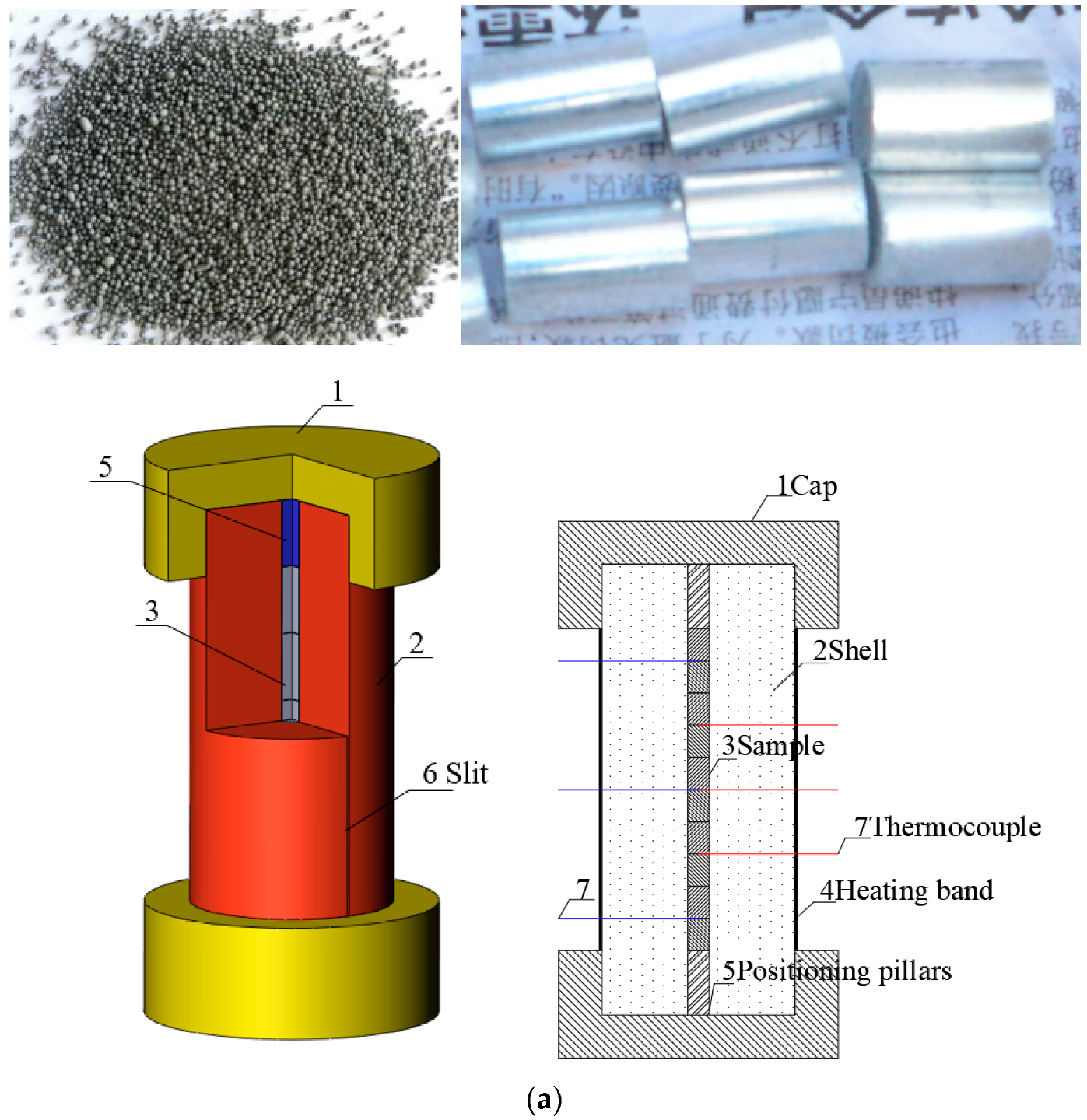


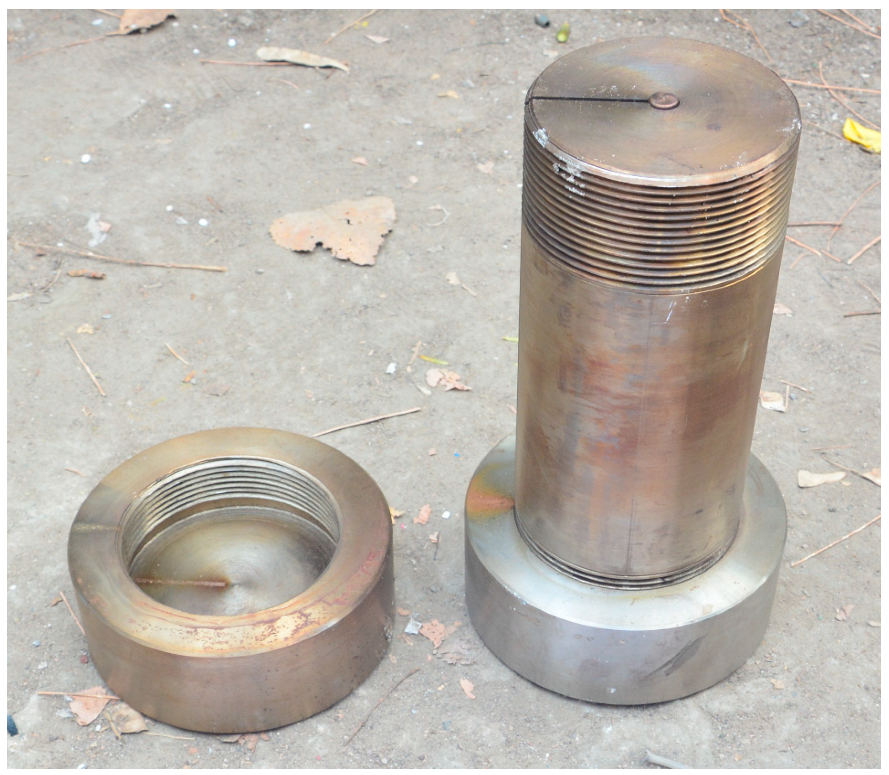

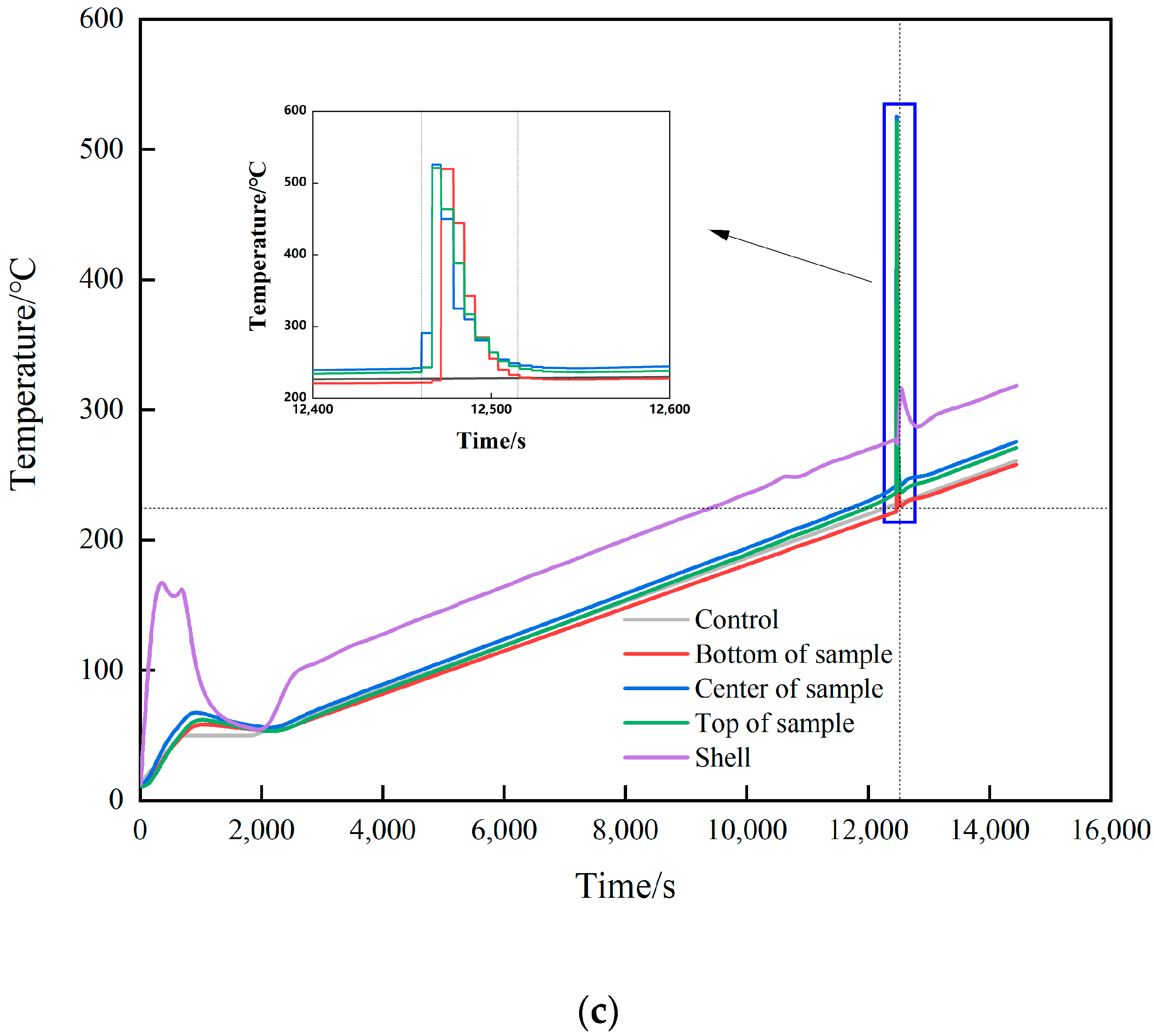
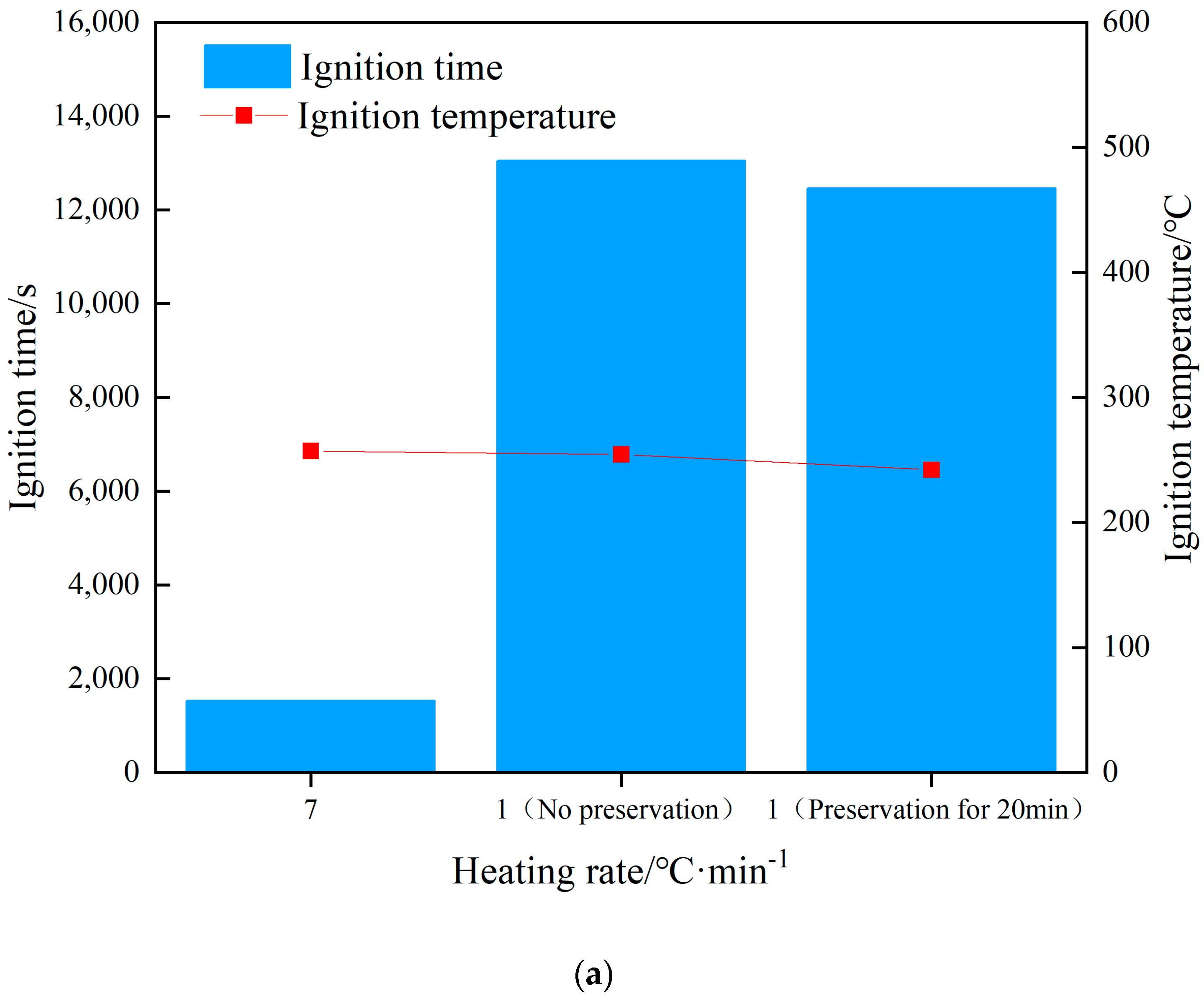
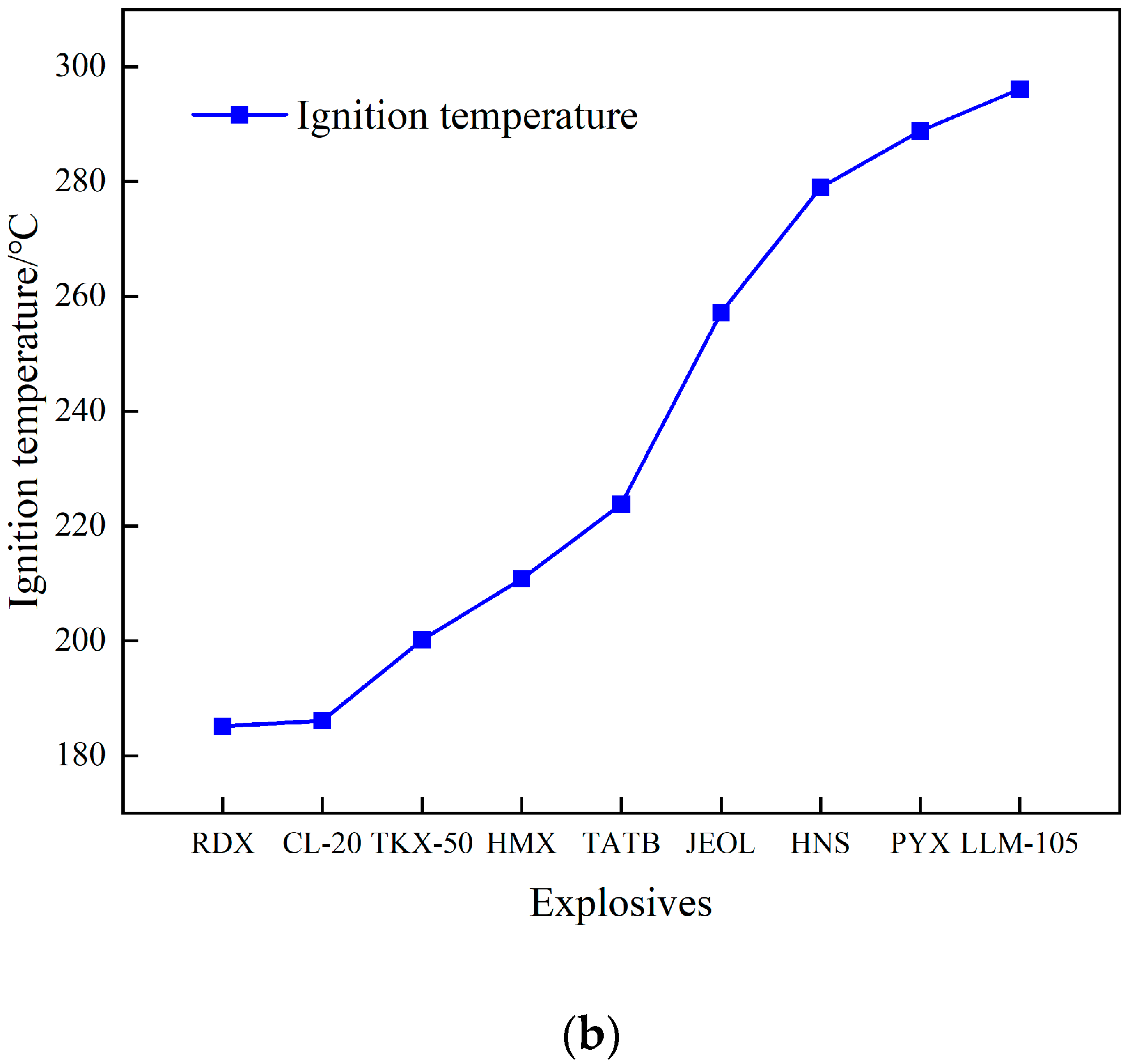
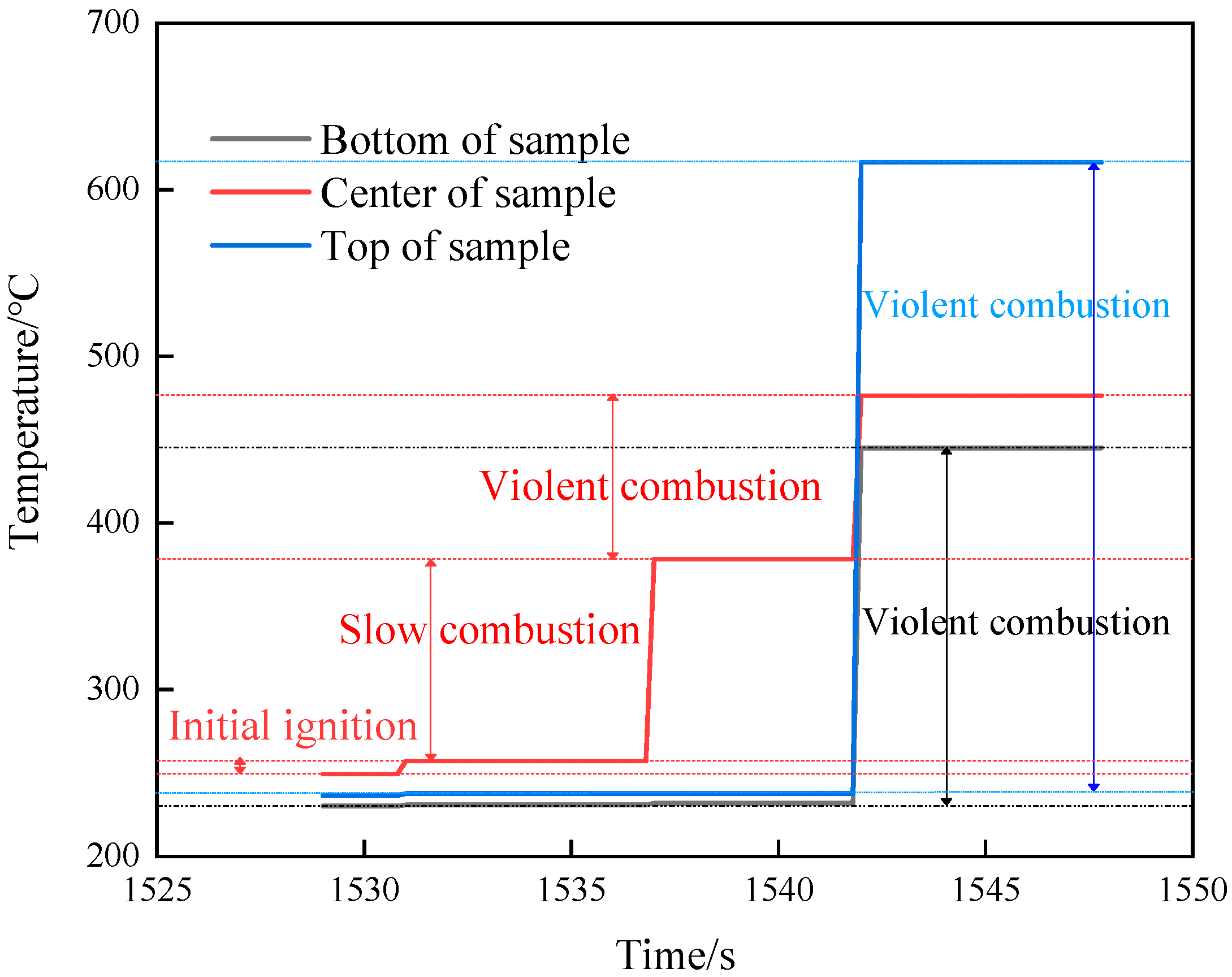

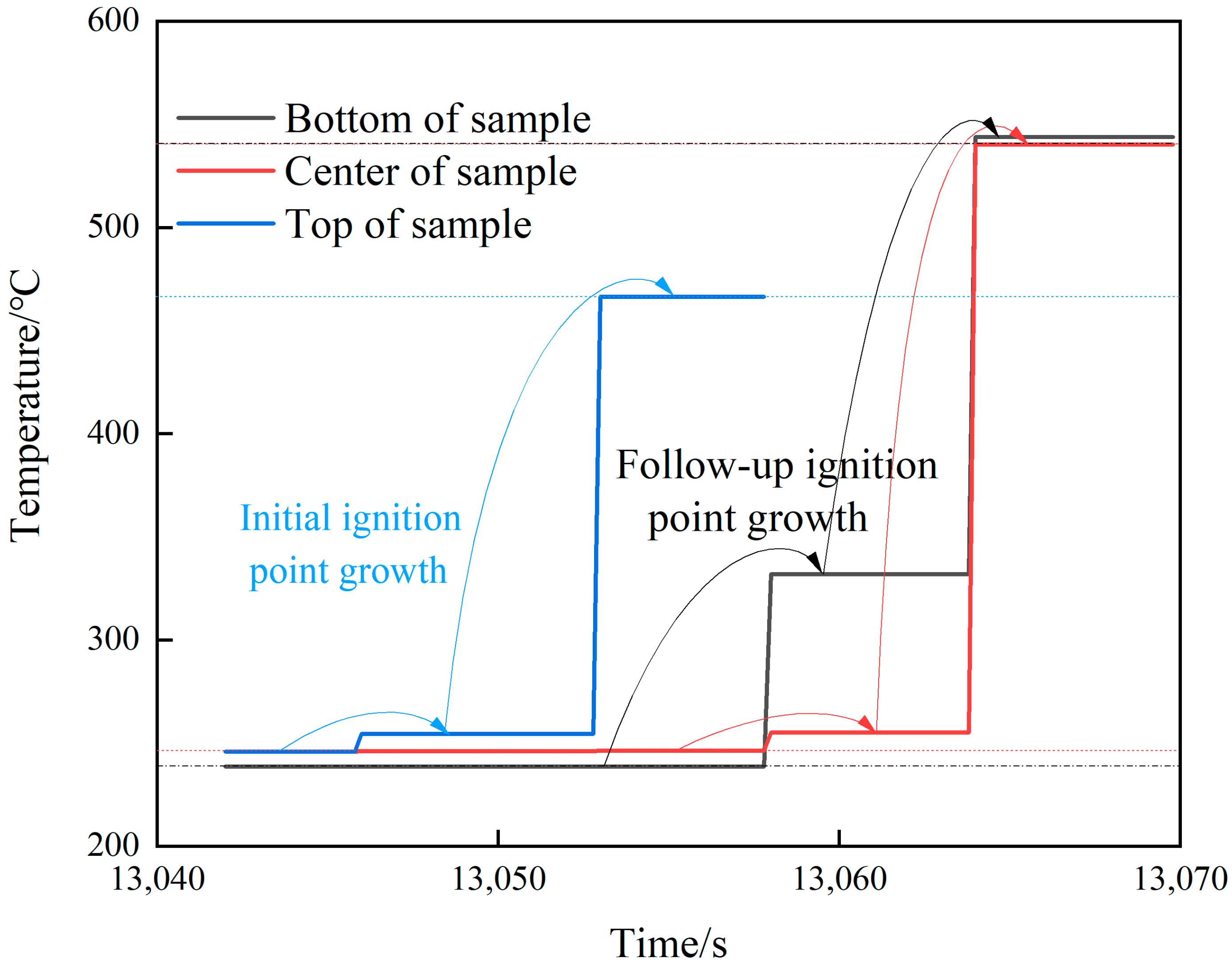
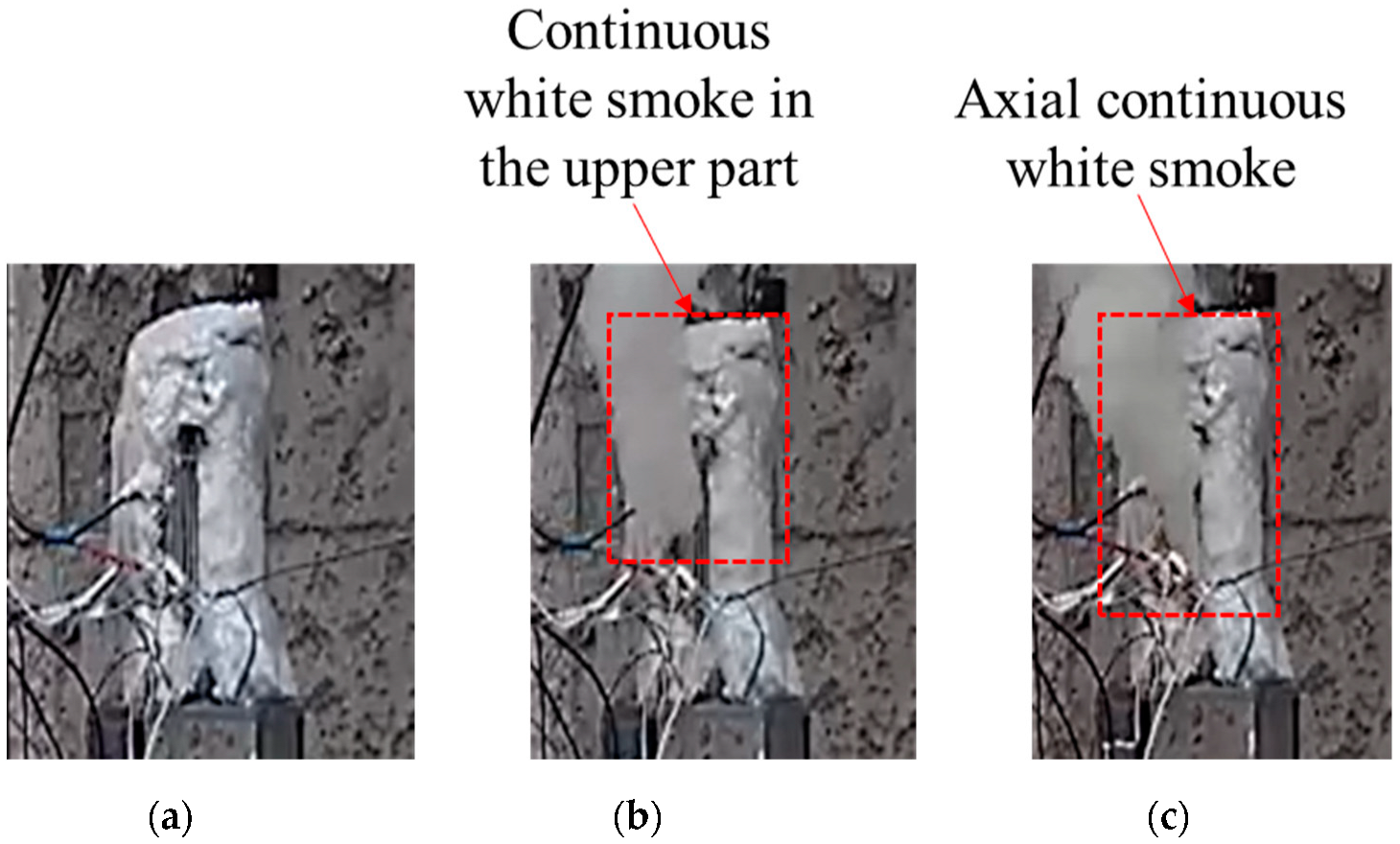
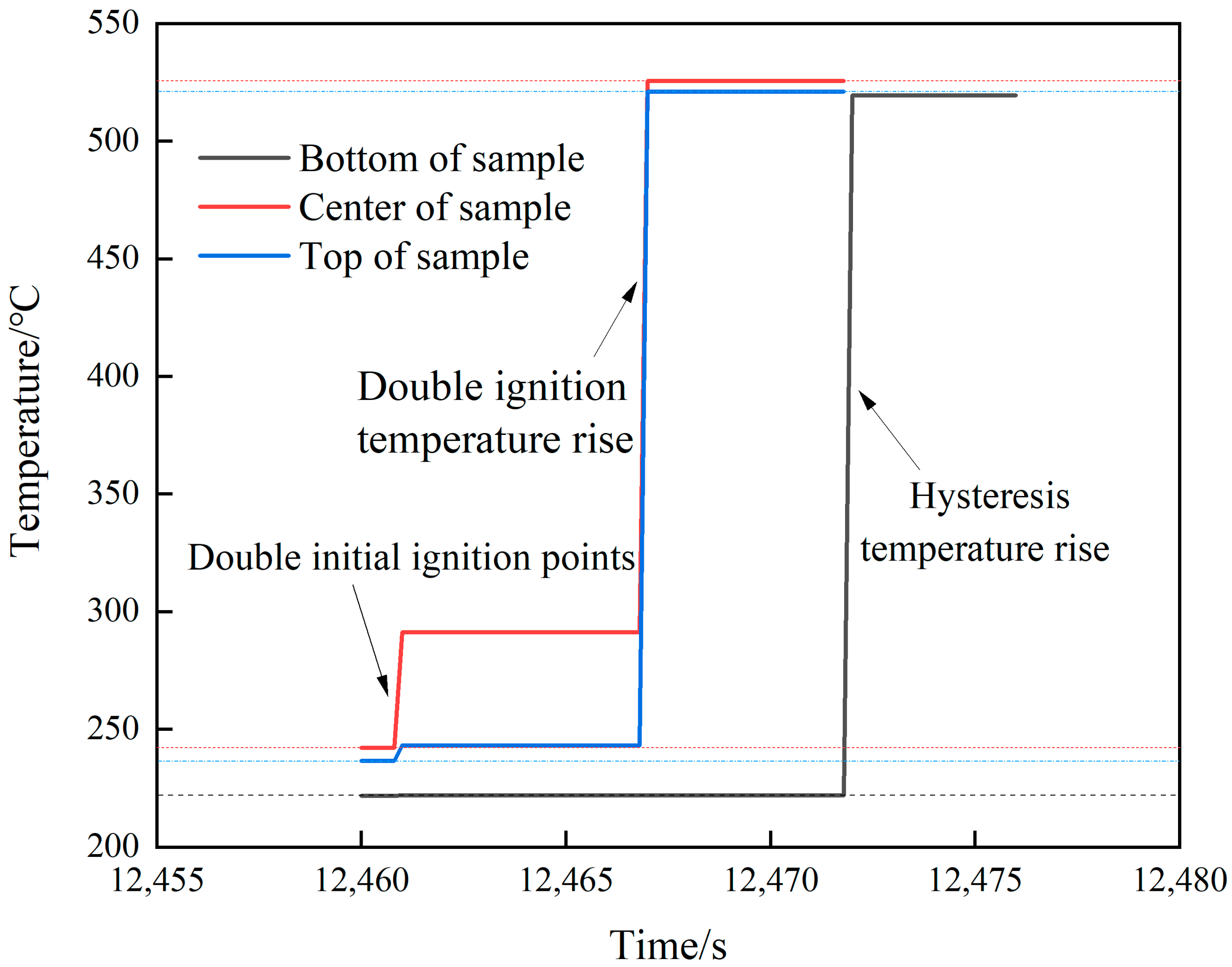
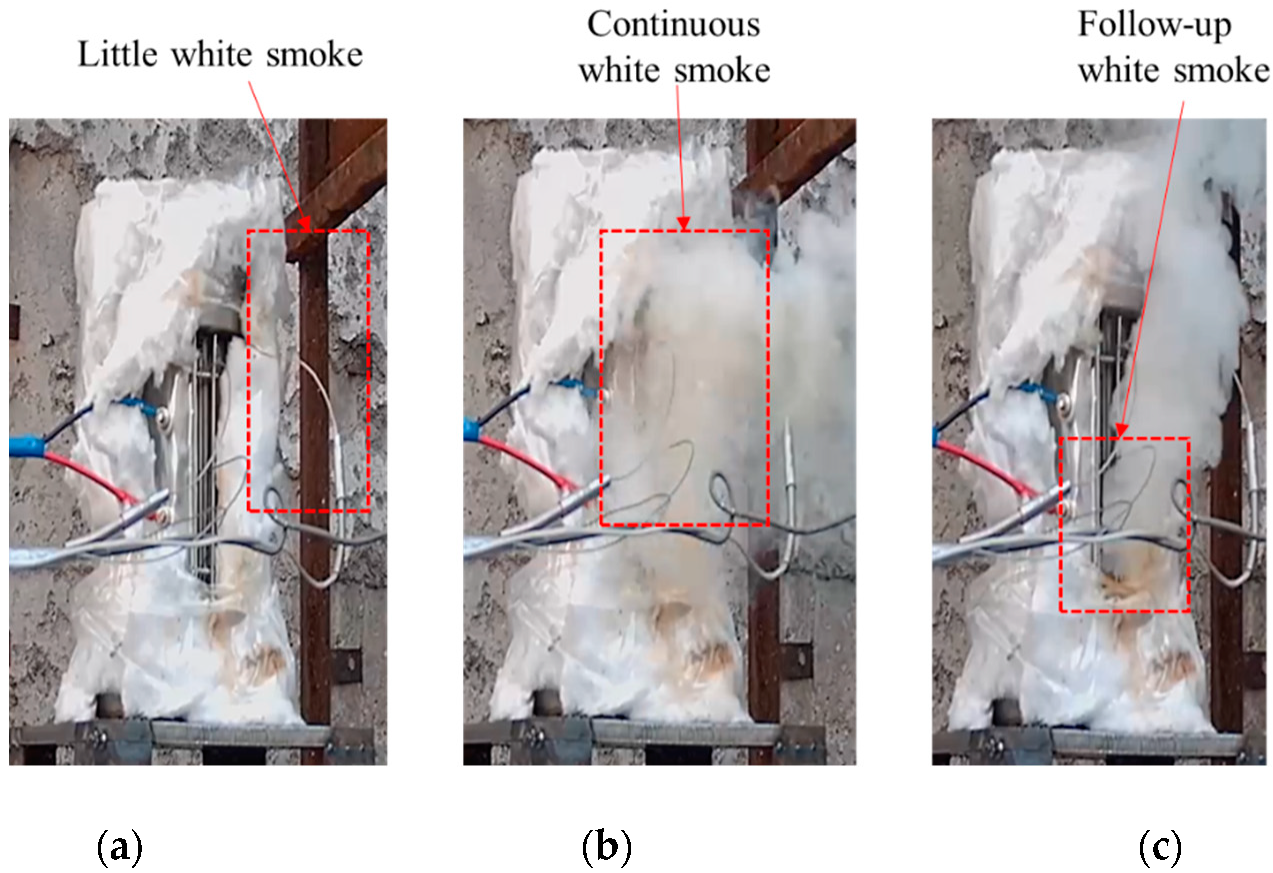
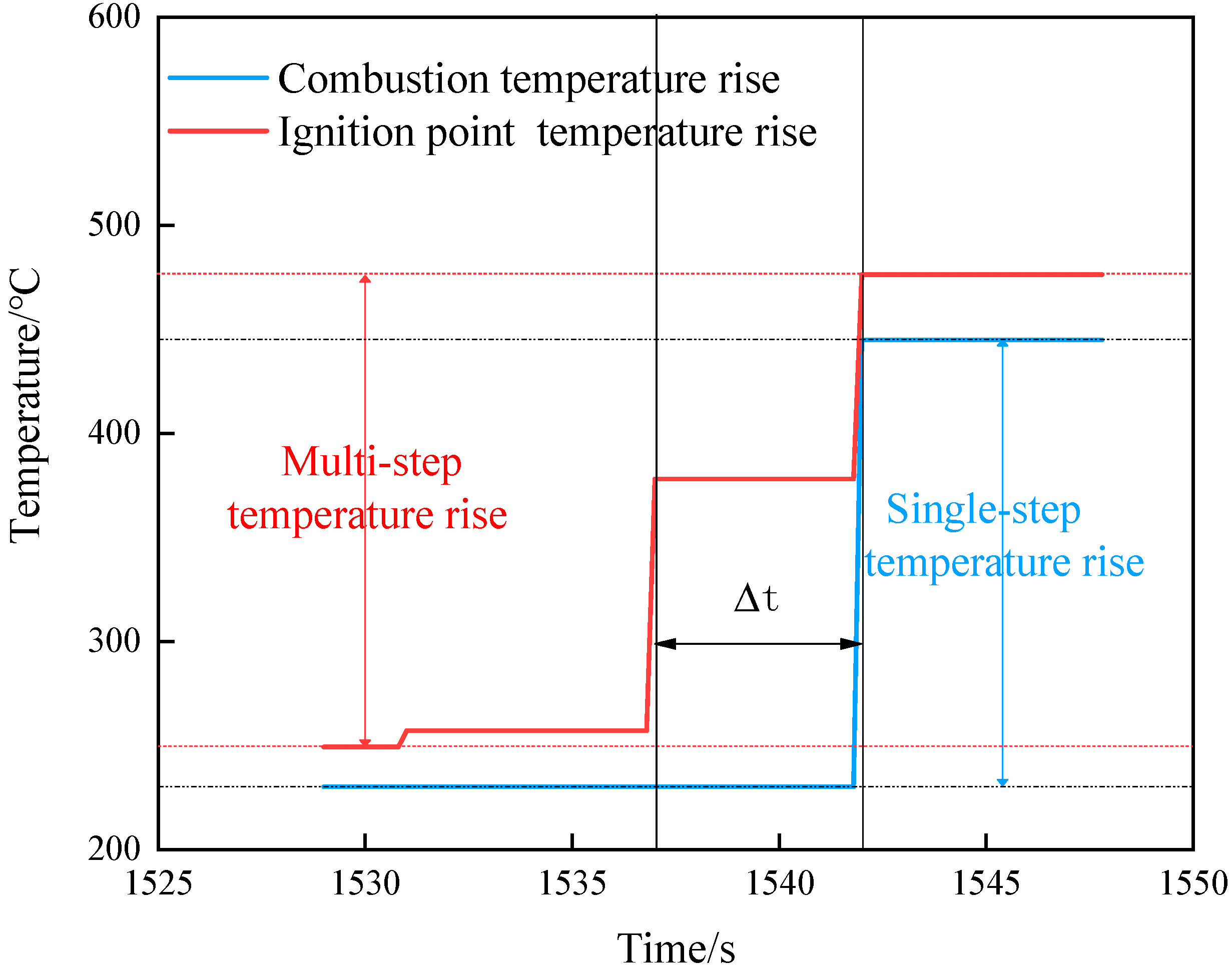
| Composition | |||
| 32 wt% 1,3,5,7-tetranitro-1,3,5,7-tetrazocane (HMX) | 32 wt% 5-nitro-1,2-dihydro-3H-1,2,4-triazin-3-one (NTO) | 28 wt% Al | 8 wt% binder system (hydrocarbon polymer as binder, dinitro compounds as plasticizer, wax as insensitive agent) |
| Shock sensitivity 1 | Friction sensitivity 2 | Heat of detonation (kJ/kg) | Velocity of detonation(m/s) |
| 18% | 15% | 6790 | 7821 |
| Shot | Heating Rate (°C/min) | Position of Thermocouple |
|---|---|---|
| 1 | 7 | Red |
| 2 | 1 | Red |
| 3 | 1 1 | Blue |
| Position | Shot 1 | Shot 2 | Shot 3 | ||||||
|---|---|---|---|---|---|---|---|---|---|
| Temperature before Ignition/°C | Initial Ignition Temperature/°C | Temperature Variation/°C | Temperature before Ignition/°C | Initial Ignition Temperature/°C | Temperature Variation/°C | Temperature before Ignition/°C | Initial Ignition Temperature/°C | Temperature Variation/°C | |
| Top | 236.4 | 237.6 | 1.2 | 245.9 | 254.6 | 8.7 | 236.5 | 243.2 | 6.7 |
| Center | 249.4 | 257.2 | 7.8 | 245.9 | 246.1 | 0.2 | 242.2 | 291.2 | 49 |
| Bottom | 230.2 | 230.9 | 0.7 | 238.6 | 238.7 | 0.1 | 221.8 | 222 | 0.2 |
Publisher’s Note: MDPI stays neutral with regard to jurisdictional claims in published maps and institutional affiliations. |
© 2022 by the authors. Licensee MDPI, Basel, Switzerland. This article is an open access article distributed under the terms and conditions of the Creative Commons Attribution (CC BY) license (https://creativecommons.org/licenses/by/4.0/).
Share and Cite
Wang, X.; Jiang, C.; Wang, Z.; Lei, W.; Fang, Y. Ignition Growth Characteristics of JEOL Explosive during Cook-Off Tests. Crystals 2022, 12, 1375. https://doi.org/10.3390/cryst12101375
Wang X, Jiang C, Wang Z, Lei W, Fang Y. Ignition Growth Characteristics of JEOL Explosive during Cook-Off Tests. Crystals. 2022; 12(10):1375. https://doi.org/10.3390/cryst12101375
Chicago/Turabian StyleWang, Xinyu, Chunlan Jiang, Zaicheng Wang, Wenxing Lei, and Yuande Fang. 2022. "Ignition Growth Characteristics of JEOL Explosive during Cook-Off Tests" Crystals 12, no. 10: 1375. https://doi.org/10.3390/cryst12101375
APA StyleWang, X., Jiang, C., Wang, Z., Lei, W., & Fang, Y. (2022). Ignition Growth Characteristics of JEOL Explosive during Cook-Off Tests. Crystals, 12(10), 1375. https://doi.org/10.3390/cryst12101375








